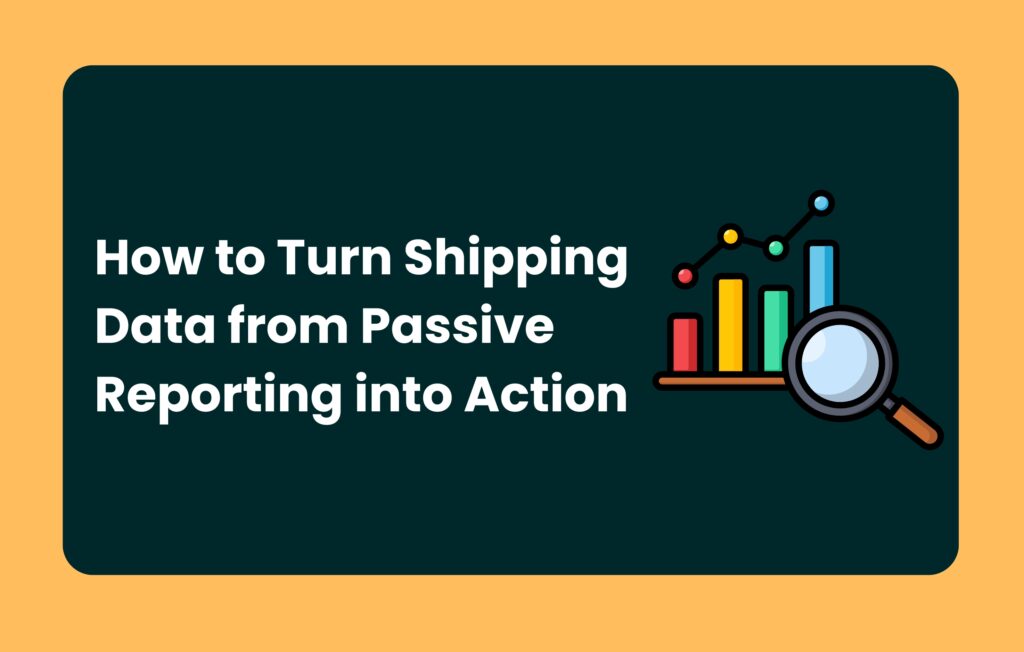- Last updated on
- November 10, 2025
- Written by:
- Amanda Conway
You’ve spent another Tuesday morning toggling between three carrier websites, trying to figure out which one won’t destroy your margins or erode your shopper experience. USPS looks cheap until you realize it’ll take seven days. UPS seems reasonable until you spot the residential surcharge. FedEx’s rate calculator just timed out again.
The USPS vs UPS vs FedEx debate isn’t just about finding the cheapest shipping carrier. It’s about decoding which one actually makes sense for your specific packages, zones, and delivery promises without spending half your week playing rate calculator roulette.
Comparing shipping rates across USPS, UPS, and FedEx in 2025 is harder than it should be. Base rates tell you almost nothing when surcharges can add 30%-50% to your final bill. Every carrier swears they’re the best shipping service while their rate sheets read like tax code.
We’ve pulled real rate data, delivery benchmarks, and cost scenarios to cut through it. You’ll see exactly when each carrier wins, where fees hide, and how to build a smarter multi-carrier strategy.
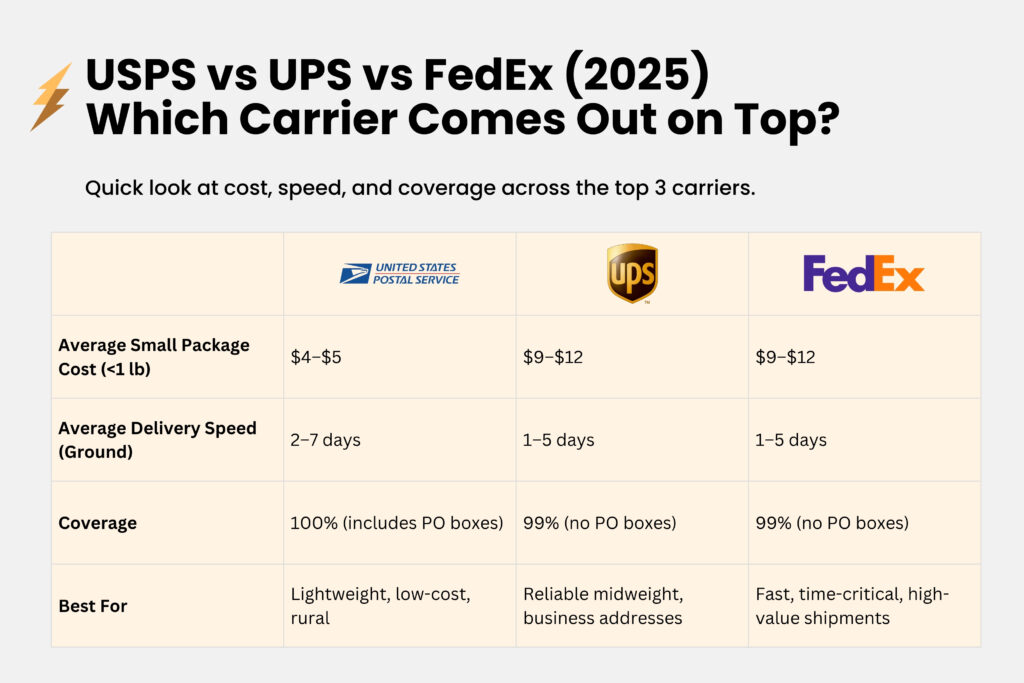
The real kicker? Package weight determines which carrier wins on cost, and the differences can swing wildly depending on whether you’re shipping a 12 oz envelope or a 25 lb box.
Table of Contents
USPS vs UPS vs FedEx: Cost Breakdown by Package Type
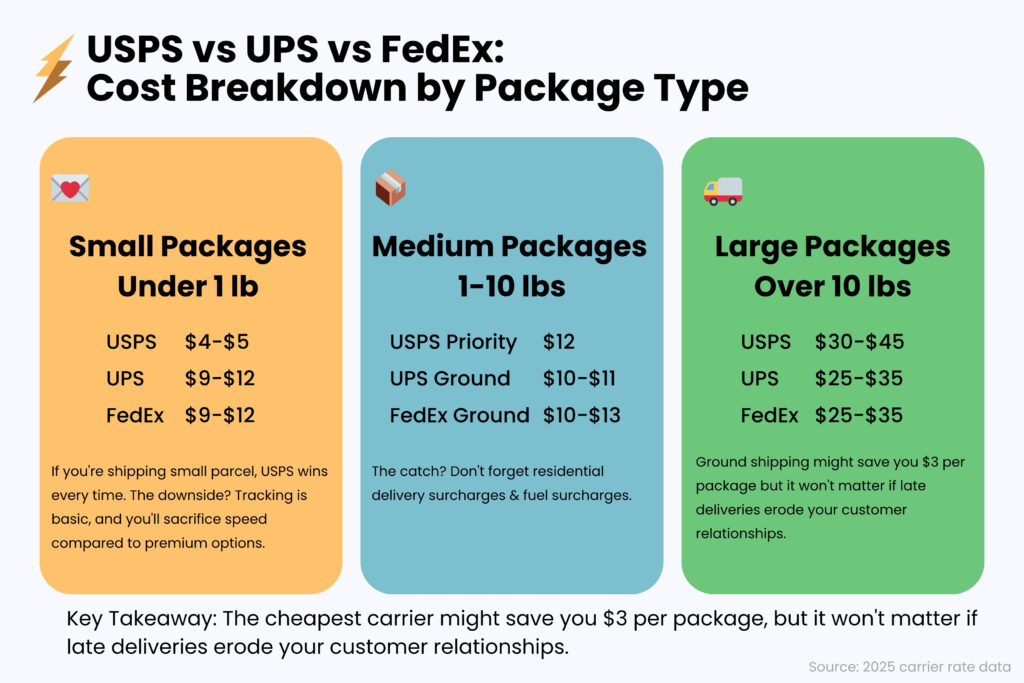
When you compare shipping rates across USPS, UPS, and FedEx, the cheapest shipping carrier changes based entirely on what you’re sending. There’s no single winner in the USPS vs UPS vs FedEx battle.
Small, Lightweight Packages Under 1 Lb
USPS dominates this category without question. First Class Package Service runs $4-$5 for a 12 oz package going cross-country, while UPS and FedEx start around $9-$12 for the same delivery. If you’re shipping apparel, accessories, or small cosmetics, USPS wins every time. The downside? Tracking is basic, and you’ll sacrifice speed compared to premium options. 2025 has been extra painful for USPS transit times.
Medium Packages 1-10 Lbs
This is where things get interesting. USPS Priority Mail stays competitive in the 1-5 lb range at $8-$15, but once you hit 6+ lbs, UPS and FedEx Ground become serious contenders. A 8 lb box from Chicago to Denver might cost $12 via USPS Priority, $10-$11 via UPS Ground, and $11-$13 via FedEx Ground.
The catch? Those UPS and FedEx rates don’t include residential delivery surcharges (add $4.50-$5.30) or fuel surcharges. When you’re doing a true shipping cost comparison you must look beyond base rates.
Large and Heavy Packages Over 10 Lbs
UPS and FedEx pull ahead here, especially if you’ve negotiated volume discounts or a larger dim divisor. A 25 lb package shipping coast-to-coast runs $30-$45 with USPS, but you can often get UPS or FedEx rates in the $25-$35 range. The question “Is FedEx or UPS cheaper” at this weight usually comes down to your specific discount tier, your dim divisor and destination zone.
Price isn’t everything when your customer expects their order by Friday. Ground shipping might save you $3 per package, but it won’t matter if late deliveries erode your customer relationships.
Delivery Speed and Service Level Comparison
Ground Service Timeline Reality
USPS Ground Advantage delivers in 2-5 business days for most routes, though cross-country shipments regularly stretch to 6-7 days. UPS Ground and FedEx Ground both promise 1-5 business days, depending on distance, with more consistent transit times than USPS for zones 5-8.
The difference? UPS and FedEx calculate ground delivery based on actual distance and network optimization, while USPS relies on regional processing facilities that can add unexpected delays. Shipping from California to New York takes 5 days with any carrier. California to Nevada? USPS might take 3 days while UPS delivers in 2.
Expedited and Overnight Options
When you need speed, the USPS vs UPS vs FedEx comparison gets simpler. USPS Priority Mail (1-3 days) costs less but offers zero guarantees. UPS 2nd Day Air and FedEx 2Day provide actual committed delivery with money-back guarantees. For overnight, FedEx Standard Overnight and UPS Next Day Air compete directly on reliability, with FedEx typically winning on Saturday delivery coverage and later cutoff times.
Low rates mean nothing if your carrier can’t actually reach your customer’s door or if a lost package turns into a three-week claim nightmare.
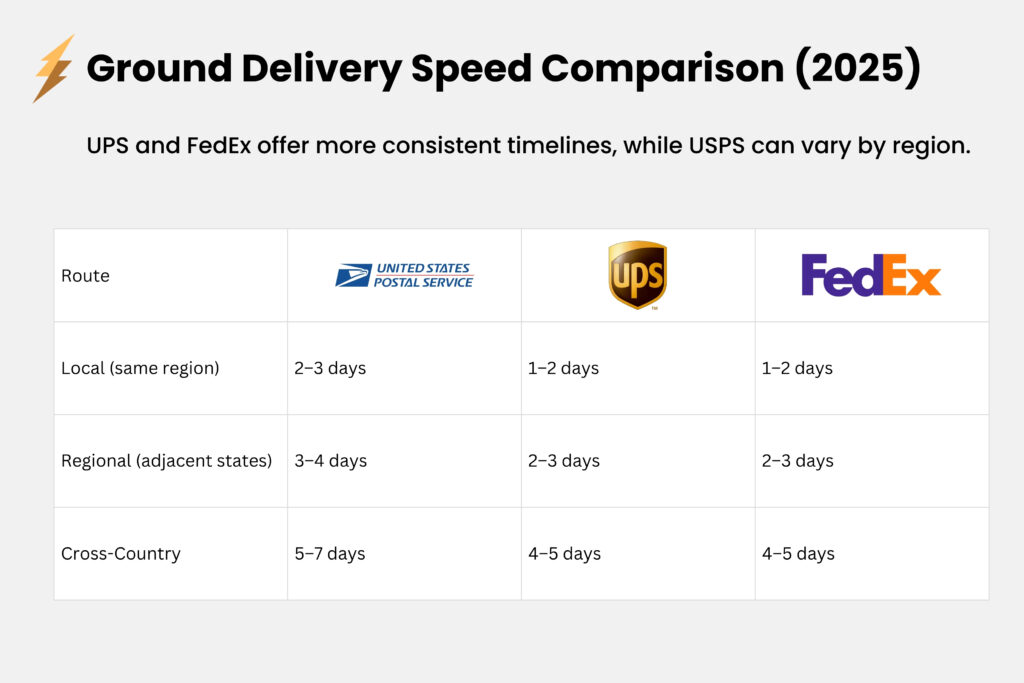
Coverage, Tracking, and Reliability Factors
Geographic Coverage and Delivery Access
USPS wins on pure geographic reach in this USPS vs UPS vs FedEx comparison – they deliver to every single address in the US, including PO boxes that UPS and FedEx can’t touch. If you’re shipping to rural Montana, northern Maine, or Alaska, USPS is often your only reasonable option without paying premium rates.
UPS and FedEx cover roughly 99%+ of US addresses but charge residential surcharges ($4.95-$5.40) on top of base rates for home deliveries. They’ll also hit you with extended delivery area fees for remote zones, sometimes adding $3-$6 per package. These fees add up fast when you’re comparing shipping rates across carriers.
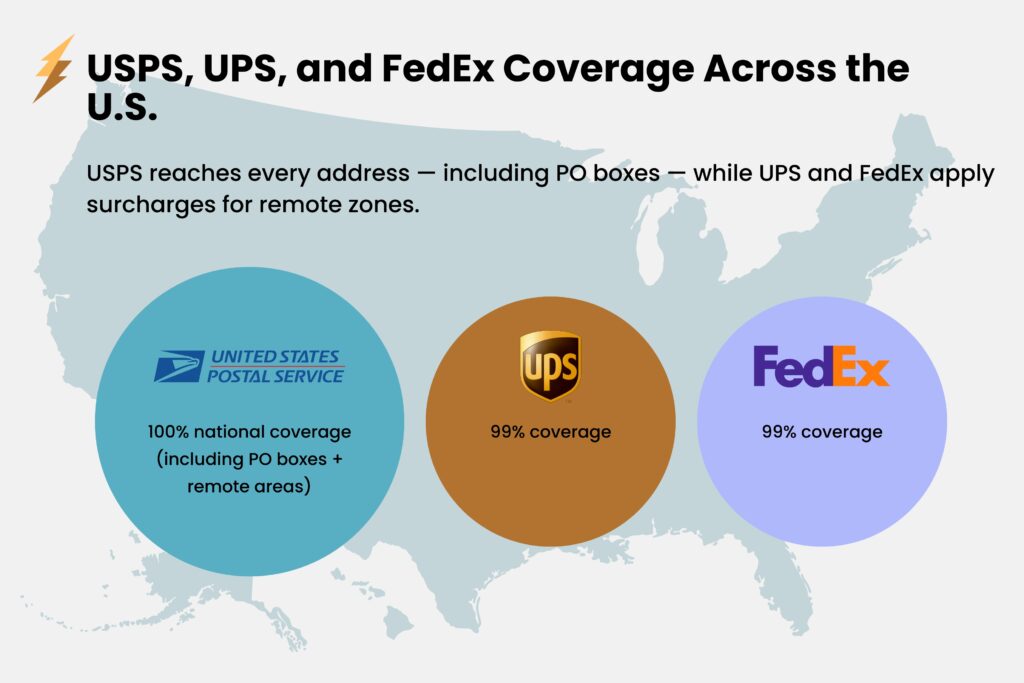
Tracking, Insurance, and Claims Process
All three carriers offer basic delivery tracking, but UPS and FedEx provide more granular updates with better real-time visibility. USPS tracking can lag by several hours or skip scans entirely at smaller rural facilities, leaving your customers wondering where their order actually is.
Shipping insurance is included up to $100 with USPS Priority Mail and most UPS/FedEx ground services. Filing claims? UPS typically processes online claims in 7-10 days. USPS can stretch to 30+ days and requires physical paperwork for claims over $200, which delays reimbursement considerably.
You’ve got the data. Now comes the part where you actually decide which carrier to use for tomorrow’s shipments.
Choosing the Right Carrier: Strategic Use Cases
The best shipping service depends on what you’re sending and where it’s going. Skip the daily rate comparison paralysis and match your packages to these strategic scenarios.
When USPS Makes the Most Sense
Stick with USPS for lightweight packages under 1 lb, anything going to a PO box, and shipments to rural or remote addresses where UPS and FedEx tack on extra fees. Their flat-rate boxes also shine when you’re sending dense, heavy items that fit within the size limits. If your customer isn’t in a rush and you’re watching margins closely, USPS Ground Advantage wins on cost for packages under 5 lbs.
When UPS Is Your Best Option
UPS Ground makes sense for packages in the 5-20 lb range heading to commercial addresses. Their reliability and consistent transit times matter when you’re shipping replenishment inventory or handling B2B orders where a day’s delay creates problems. The tracking is solid, and their pickup infrastructure beats USPS if you’re shipping volume regularly.
When FedEx Delivers the Best Value
Choose FedEx when speed matters more than saving $2. Their 2-day and overnight services consistently outperform competitors on time-critical shipments. FedEx also handles high-value items well, with better insurance options and claims processes than USPS for packages worth protecting.
The Bottom Line
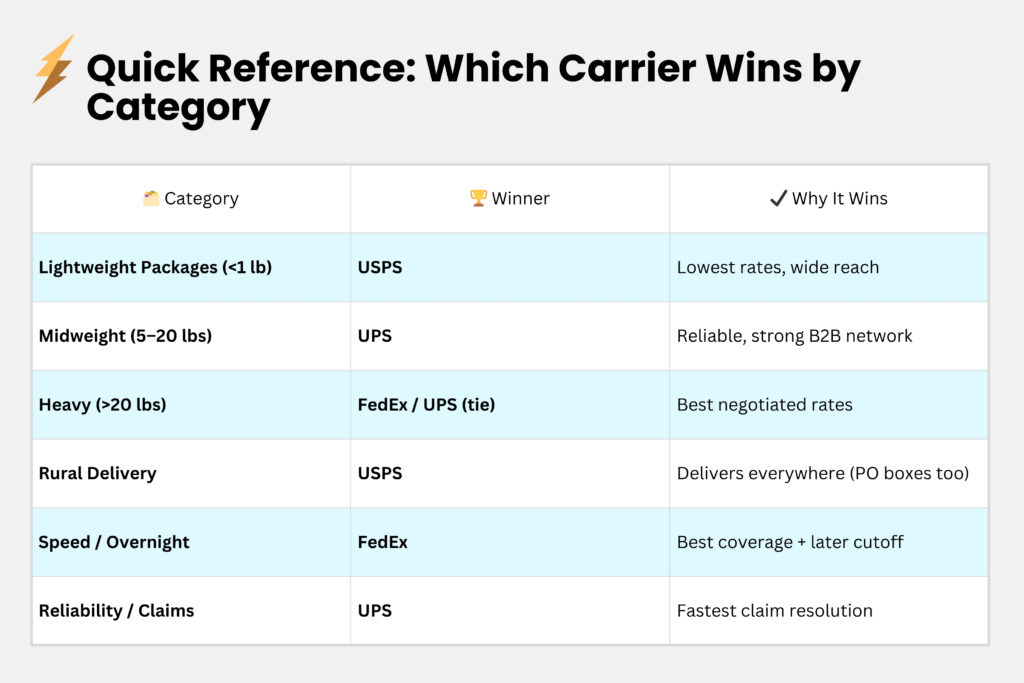
No single carrier wins across the board. USPS dominates for lightweight packages under 1 lb and rural deliveries, UPS Ground takes the middle weight range of 5-20 lbs with consistent reliability, and FedEx owns time-sensitive shipments where speed justifies the premium. The carriers that destroy your margins are the ones you pick out of habit instead of strategy.
The carriers that destroy your margins are the ones you pick out of habit instead of strategy. And once you’ve optimized across USPS, UPS, and FedEx, high-growth businesses often discover they need specialized last-mile partners for specific routes, delivery windows, or customer experience requirements that the big three weren’t built to handle.
Here’s what you should do next:
- Audit your last 100 shipments by weight and destination to identify where you’re overpaying
- Set up accounts with all three carriers to access commercial rates and compare real costs including surcharges
- Build simple decision rules based on weight brackets and zones so your team stops guessing
- Test a multi-carrier shipping platform that rate-shops automatically if you’re shipping 50+ packages weekly, or explore specialized last-mile carriers like GoBolt that optimize for specific routes and delivery requirements
Stop defaulting to one carrier for everything. Match each package to the carrier that makes financial sense for that specific shipment, and your shipping costs will drop without sacrificing delivery performance.
FAQ
✉️ Which carrier is cheapest for small packages under 1 lb?
USPS wins this category by a significant margin. First Class Package Service costs around $4-$5 for a 12 oz package cross-country, while UPS and FedEx start at $9-$12 for the same delivery. If you’re shipping lightweight items like apparel or accessories, USPS is your most cost-effective option.
💲⚠️ Do UPS and FedEx charge extra fees beyond their base rates?
Yes, and these fees add up quickly. Both carriers charge residential delivery surcharges of $4.50-$5.30 per package when shipping to homes rather than businesses. They also add extended delivery area fees of $3-$6 for remote locations, plus fuel surcharges that can increase your total cost by 30% or more beyond the quoted base rate.
📭 Can UPS and FedEx deliver to PO boxes?
No, UPS and FedEx cannot deliver to PO boxes. USPS is the only carrier with access to PO box addresses, which makes them your only option if your customer uses a PO box for deliveries.
⏱️ How long does it take to process a shipping claim with each carrier?
UPS typically processes online claims in 7-10 days. USPS can take 30+ days and requires physical paperwork for claims over $200, which significantly delays reimbursement. FedEx falls somewhere between the two, with better claims processes than USPS for high-value items.
⚖️ At what package weight do UPS and FedEx become cheaper than USPS?
The crossover point is typically around 6-10 lbs, depending on your destination zone and whether you have negotiated business rates. USPS Priority Mail stays competitive for 1-5 lb packages, but once you hit 6+ lbs, UPS and FedEx Ground often offer better rates, especially for packages over 10 lbs going long distances.





